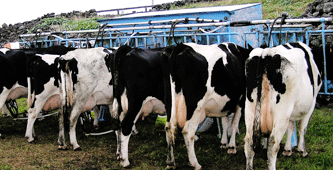 COUNTRY OF ORIGIN
COUNTRY OF ORIGINGrazing dairy cows, a model of sustainable agriculture
The problem it solves
Among the animal or vegetable products which man uses for food, milk is the most important and natural, and can provide all the nutrients needed for development.
Man has substituted human milk with that of many different animals, such as horses, donkeys, goats or camels. But it is cows milk which is produced and consumed in the greatest quantity, both because of its organoleptic qualities, which makes it very similar to human milk, and because it is easy and cheap to produce.
The fact that cows milk is of extreme importance for man means that production techniques and methodologies are of considerable interest.
Basically, milk production is carried out in three ways:
- intensively
- semi-intensively
- extensively

Intensive farming
Intensive farming, which is typical of low-lying industrial countries, generally involves:
[list]Keeping animals in barns and milking them in parlours;
[list]Infrastructure for storing fodder (crops are available for just a few months of the year), which is then fed to the animals for long periods of the year;
[list]Massive use of flour from cereals, oleaginous seeds and industrial by-products, accompanied by supplements such as bicarbonate of soda to prevent abnormal ruminative fermentation
This technology has led to an increase in milk production from the traditional 5-15 litres to 30-40 litres a day.
It is a model which requires a great deal of financial resources, capital investment, and technical know-how, and has led to excessive milk production, forcing the European Union to implement a quota regime.
The system has some intrinsically negative aspects. It has led to:
- a big drop in the number of producers and a rise in the number of heads per farm;
- reduced average production life of cows, and a fall in births from 5-6 to 2-3 calves;
- environmental pollution caused by intensive production of fodder to feed the cows and difficulties in collecting and treating effluent;
[list]milk and dairy products lacking organoleptic qualities and increasingly causing food intolerance.
The system consumes a lot of energy and ceases to be functional when energy input is greater than production output, as recently happened with the increase in oil prices, which affects many aspects of intensive farming.
Extensive farming
Extensive farming is typically used in meat producing countries, where cattle graze over large areas of land and the animals are only herded when they are taken to the slaughterhouse.
Semi-intensive farming
The semi-intensive model used in the Azores has specific characteristics: dairy cattle graze all year round; there are few barns or farm buildings to stock food, since the cows are always out at pasture; natural grazing is complemented by fodder and concentrate, the latter used as supplements in times of bad weather or administered at the discretion of the breeder.
This model of dairy cattle farming has developed from the environmental characteristics of the Azores. The archipelago of the Azores is located in the centre-north of the Atlantic Ocean, about 1500 kilometres from the Portuguese mainland. It is made up of nine islands of volcanic origin: it has a temperate wet climate, an average temperature of 16.9°, an average rainfall of over 1000 mm, spread evenly throughout the year, and an average relative humidity of 80%. The archipelago, which has an area of 2332 km2, constitutes 2.5% of the total area of Portugal, but with nearly 93.831 dairy cows bred in 4672 mostly family-run farms averaging 8.8 hectares in size, it provides nearly 30% of the country’s milk production.
The agricultural sector, more than the service, fishing or tourism industries, has seen development over the last few years, due mostly to the environmental and conservationist concerns of the region.
Agriculture, namely dairy farming, has been the main driving force for socio-economic development in the Azores. Proof of this is the significant number of young people that have taken up agricultural activities over the past few years.
DOWNLOAD THE BROCHURE PDF
English (0.8 MB)Spanish (0.8 MB)
Portuguese (0.8 MB)
ONLY TEXT
•Grazing dairy cattle in practice







